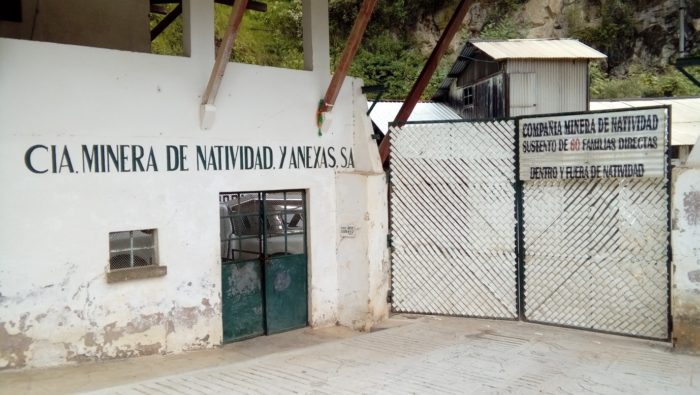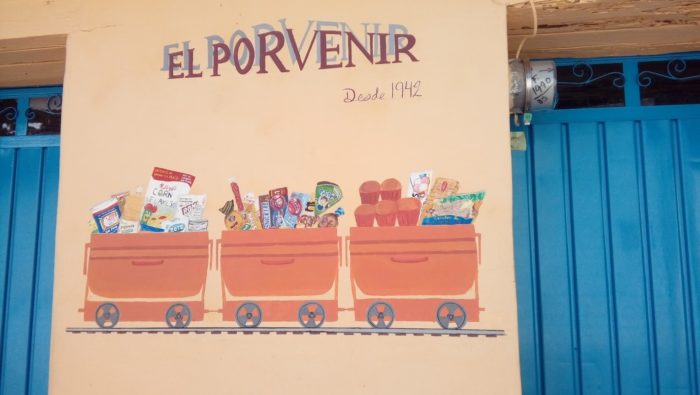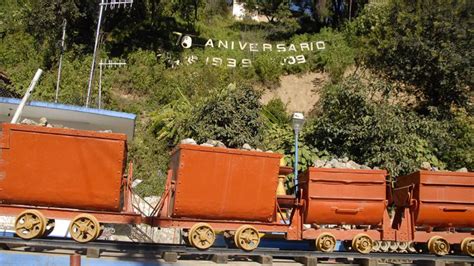Conversing with Goliath is a research project carried out by FLACSO-Mexico and De Montfort University, Leicester, UK, sponsored by the British Academy (2017-2020). The project aims to understand why violence in Mexico persists in the design and implementation of projects in the extractive industry when a wide range of participatory institutions exist in law and policy programmes which, in principle, promote citizen participation (information, consultation and deliberation).
In the second of three articles based on the research, Adrián Jiménez Sandoval of the National Autonomous University of Mexico looks at the very different experiences of two neighbouring communities. Capulalpam, as documented in our first article, successfully fought against a forestry company and a mine. Adjoining Natividad fought with its neighbour rather than the companies and looked to the mine to solve its problems.
The neighbouring communities of Capulalpam de Méndez and Natividad are so close that a visitor might not notice when they had left one and entered the other. This is not unusual in Oaxaca State, which has 570 of the 2,458 municipalities in Mexico. Despite sharing many things in common, there has long been conflict between the two about their territorial boundaries. Now the advent of gold mining projects that span both has made things much worse.
The two municipalities are located in the Ixtlán district, which together with the Mixe and Villa Alta districts form the Sierra Juárez Region in the State of Oaxaca, south-eastern Mexico.
Spanish and Zapotec are spoken in both Capulalpam and Natividad. Many people from both municipalities intermarry so that families extend across boundaries. The places are governed by customary law, organized through citizen assemblies where the problems of the municipality are discussed and agreements made; citizens carry out community work, also called tequio which follows a progressive hierarchical system . You can start with sweeping the streets and can end up becoming municipal president. Each post lasts only eighteen months, and the post-holder must leave her/his paid work and undertake community work voluntarily.
The conflict centres on who owns the land: is it the communal agrarian authorities of Capulalpam or the individual citizens of Natividad who have historically depended on it?
The conflict has not been resolved. On the one hand, Capulalpam is not willing to concede any arrangement that could jeopardize its community’s internal cohesion which, as mentioned in the first blog of this series, has achieved international prestige in the fight against gold mining.
On the other hand, Natividad is looking for alternatives to overcome the economic crisis it faces, but until now community members have been unable to reach a unanimous position on what should be done.
In the midst of this dispute, we find a private gold mine, ‘Minera Natividad y Anexas’ that, in order to become profitable, needs to change the way it operates and which prefers to negotiate with Natividad rather than Capulalpam.

In Capulalpam land ownership is communal, and the Community Assets Commissariat decides what to do with land and with the community enterprises which depend on it. In contrast, people in Natividad own their homes and little else, they own no land on which to plant crops or extract wood. Previously the mine employed people from Natividad and brought in others from across the region. However, since the 1960s declining production created a crisis for Natividad’s economy.
Capulalpam, as described in the first article, has experience in halting extractive projects in its territory, forging a network of alliances with other municipalities of Ixtlán and Mixe districts with whom they share their communal vision on natural resource management. This network has been joined by research centres, non-governmental organizations and some state agencies, interested in its success.
In the 1980s, Capulalpam and other municipalities fought against the Tuxtepec Paper Factory’s forestry concession in the Sierra Juárez. After succeeding in getting the concession revoked, these communities created various different community enterprises beyond the forestry sector.
In 2005, the University of the Sierra Juarez was created with studies in forestry and ecotourism, which strengthened community enterprises (a water bottling plant, a stone construction factory and a toy factory). In addition, Capulalpam benefited from the Magic Town federal program which has promoted tourism.
Members of the community of Capulalpam also work in other universities in Oaxaca who have helped to formulate strategies for opposing extractive projects in their territory through an alternative vision of sustainable exploitation and transformation of their resources. The latter has been acknowledged by national and international civil society organizations who celebrate their success in defending the environment under threat from extractive projects.
For their part national government agencies lack a consistent approach on how to resolve the conflict between the two municipalities because there are contradictions between the objectives they pursue. On the one hand there are agencies that seek to protect the environment and communal land and property and, on the other hand, those that promote mining as an economic activity to trigger the development of impoverished municipalities such as Natividad. The authorities in Capulalpam, however, have been able to exploit these inconsistencies to bolster their struggle.
A sharp decline in production at the mine began in the 1990s, causing unemployment and migration to the state capital, Mexico City and the United States. This was aggravated in 1993 when a presidential decree turned the territory that Natividad currently occupies into communal land under the jurisdiction of its neighbour Capulalpam, leaving the former without access to land for its own population’s subsistance.
During the first years, this decree did not cause major problems until Natividad sought to challenge it through a lawsuit presented to the Agrarian Court. Although the dispute over the territory had begun before 1993, the conflict escalated in 2003 when Natividad ran out of water because the pipelines that supplied them were cut off by the Capulalpam authorities in retaliation for the lawsuit.
Meanwhile, between 2002 and 2006, the Canadian firm Continuum Resources carried out exploratory studies to assess the viability of making new investment in the underperforming gold mine. Given its former prestige this was a potentially attractive venture, especially if the new mining could be open-cast. Although the mine, belonging to Natividad y Anexas, is registered as located in Natividad, the proposed project would have had a considerable impact on neighbouring Capulalpam.

Canadian investors wanted to negotiate with the community of Capulalpam permission to survey their territory but the communal-land authorities categorically rejected it; they were not interested. The insistence of the investors was understood as an offence and the operation of the mine as a threat. So the Community Assets Commissariat demanded the intervention of the Federal Prosecutor for Environmental Protection and the Ministry of Environment who have repeatedly closed down the mine and more recently its tailings dam. This type of intervention scared the investors into closing down the operation and leaving the area.
The temporary closures of the mine caused crisis in Natividad where the authorities had viewed the arrival of the investors as a second opportunity to reactivate their economy. To pursue the fight over what Natividad considered to be their land, the authorities set up their own agrarian assembly, which works as the counterpart of Capulalpam’s Community Assets Commissariat. Through lawsuits and injunctions, Natividad has suspended forestry activities that Capulalpam’s community enterprises carry out.
However, the agrarian assembly is not recognized by all state agencies. While the Agrarian Prosecutor’s Office does not recognize it, the Ministry of Indigenous Affairs stresses that because Natividad is governed by customary law decisions of self-governance are to be respected.
But Natividad is not the only party to oppose Capulalpam. The Directorate of Industry and Mining of the Ministry of Economy in Oaxaca also wants the mine to continue its operations, although without using its tailings dam, which would limit its production. As a result of these contradictions, the mine does not pay taxes for the minerals extracted since it is ‘formally’ closed.
Although the authorities in Capulalpam have denounced the mine’s continuing operations, which puts its community at risk, and have impounded trucks loaded with mineral, government authorities have taken no action. In the meantime, mining company Natividad y Anexas has given ‘support’ to Natividad authorities, who have used the money to finance the long-lasting lawsuit against their neighbours.
In Natividad the community has been divided into different camps. The agrarian authorities are determined to bring the agrarian trial to its final consequences, but there are also citizens who have proposed converting their municipality into a sub-district of Capulalpam. Capulalpam authorities reject this suggestion as they fear their own internal cohesion may break down if Natividad joins and its citizens vote to open the door in future to mining entrepreneurs.
What can we learn from this conflict?
One community (Capulalpam) has been able to isolate another (its neighbour Natividad) by building a network of alliances with anti-mining communities, organizations and agencies that share their vision. This network exacerbates the crisis of the isolated community through a double stigmatization. On the one hand, pro-mining state agencies stigmatize Natividad because of its underdeveloped economy; on the other hand, other indigenous communities stigmatize Natividad for being in favour of an industry that degrades the environment. For Natividad, however, this remains the most immediate means of overcoming the economic crisis threatening the municipality.
This conflict also illustrates that conflict between communities can be exacerbated by a mining company that has indirectly benefited by being able to continue operating without paying taxes.
In the past, both communities benefited from mining, however, currently only Capulalpam has able to diversify their economic alternatives to avoid the crisis generated by the decline of the Natividad mine. Is it the type of land possession that has defined success or failure? Perhaps the answer is the need to have a minimum of individual or communal resources for alternative projects to arise. In the 1980s Capulalpam fought against a private company for control of its forests. Natividad became embroiled in a fight against its neighbor for control of the community’s land, not for the mine which was and remains private. Meanwhile, the differences between the two communities increase and projects that might benefit both are stalled.
Adrián Jiménez Sandoval is a PhD student in political and social studies at the National Autonomous University of Mexico. His research addresses the incidence of social movements and civil society organizations in political culture and legislative processes where he has conducted network analysis as a method to identify relevant actors.



